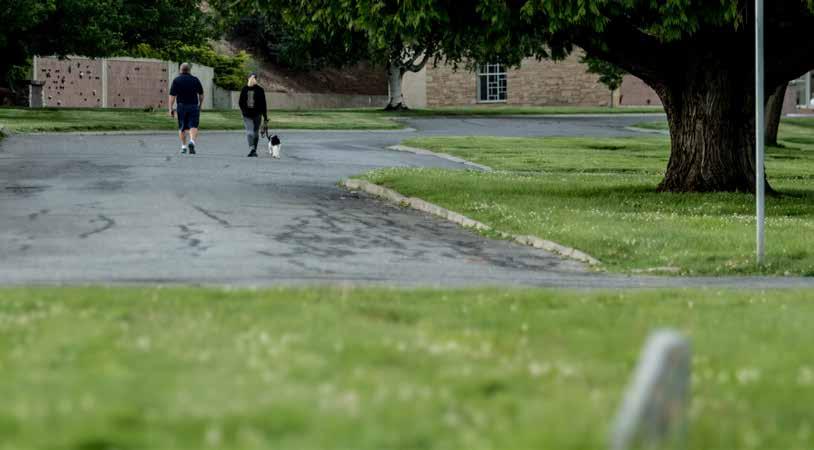
7 minute read
More than a burial place
Gravestones and leashes
Editor’s note: A version of this story first published in The Wenatchee World in 2011. Facts and figures have been updated. As a regular cemetery walker, I thought about writing a new story based on the same premise, but quickly realized I couldn’t write a better story than Mike Irwin already did. – Marco Martinez
Advertisement
Life flows through city cemetery
For Jeff Pulver, three decades of tending the Wenatchee City Cemetery grounds have reinforced one of life’s basic truths: Cemeteries aren’t just for dead people.
The constant flow of living, breathing folks through what amounts to North Central Washington’s second-larg est city — an interred population of nearly 20,000 souls — provides a satisfying reassurance that death is part of life, said Pulver, lead worker at the Wenatchee City Cemetery, which was added to the City Historic Register in 2019.
“For many people, there’s something comforting about these grounds,” he said. “They return, sometimes daily, even if they don’t have loved ones buried here. The stillness, the quiet ... they make it part of their everyday lives. It’s a good place to think about things.” Brian Daines takes his dog Hank out for an evening walk through the cemetery in early June.


Clockwise from bottom left: The grave of John and Mary Sherer dates to the 1920s.
The sun sets over the cemetery in early June.
Miranda Hamstra takes her two dogs on an afternoon walk through the cemetery in early June. Hamstra said she enjoys the serenity of the cemetery.
The 125-year-old, city-owned facility regularly hosts walkers, joggers, picnickers, dog walkers, moms with strollers, bird watchers, genealogy enthusiasts and history buffs. It’s a common scene, said Pulver. “People pay their respects and maybe get in a little exercise,” he said, nodding to an older couple striding along the cemetery’s nearly 1.3 miles of roads. “These are activities I’ve been watching for years.”
Nearly 40 years, to be exact.
Pulver first joined the cemetery staff when he was 17 years old and still in high school. It was a summer job with

decent pay, satisfying physical labor and a serene work setting.
He said he immediately liked the job but had been taking night classes at Wenatchee Valley College for a career in refrigeration repair. So, when a cemetery staffer retired, Pulver had to make a choice — indoor work or outdoor work? He joined the graveyard’s grounds crew right after high school graduation.
“It was a big decision for me at the time,” he said. “But I knew it was the right one.”
Since then, Pulver has done it all to keep the cemetery grounds inviting and the burial operation running smoothly. Mowing, trimming, planting, fertil izing, cleaning, digging, filling, setting headstones, maintaining mausoleums — all the tasks expected of a cemetery groundskeeper.
More unexpected are tasks that fall outside the regular care of lawns and buildings to include the care of the grieving and bereaved.
The cemetery’s 2.5-man staff — Pulver , Tom Lewis and Jerred Gardner — sell burial plots, offer advice on a choice of headstones, help schedule services and, generally, console and guide the bereaved during this last step of the burial process.

Clockwise from top: Pete and Cindy Fraley take their dog Bella on a walk through the Wenatchee City Cemetery in early June. Some sections at the Wenatchee City Cemetery allow flat grave markers exclusively. Cemetery staff rely on markers to accurately locate grave sites.

“But it’s usually not a heartwrenching meeting, with people crying and wailing,” Pulver said. “By the time they get to us, they’ve already met with a funeral director, been comforted by family, maybe talked with a pastor.”
Of course, people deal with grief in different ways, Pulver said. “Some cry, some laugh and make humorous remarks. But most have moved past the initial shock.”
In fact, he said, many of the people he meets have moved into a practical phase, an accepting phase, that allows them to handle the details and make the decisions needed to bury their dead. “For us, meeting and comforting

grieving people is all part of the job,” he said. “In one hour’s time, I could be mowing grass, repairing an irriga tion line, and shaking the hands of a couple buying pre-need burial lots.”
He looked out over facility’s lush 33.7 acres. “It’s part of the job,” he said. “Part of the way people flow through here.”
Facelift for city father’s mausoleum
Provided photo

The city of Wenatchee has received a grant to make needed repairs to the Clark family mausoleum. The remains of W.T. Clark, considered by some to be the “Father of Wenatchee,” are inside the mausoleum.

Work to restore the Clark mausoleum was underway in late July and into early August.
The mausoleum of one of Wenatchee’s founding fathers has been restored.
The Clark Mausoleum has 12 crypts, one which is the final resting place of W.T. Clark, who was called “The Father of Wenatchee.”
David Erickson, director of the City of Wenatchee’s Parks, Recreation and Cultural Services department that manages the cemetery, successfully applied for a $43,000 grant through the state Department of Archaeology and Historic Preservation to renovate the mausoleum.
The project replaced the roof, fixed cracks in the building, repaired the doors and provided a new coat of paint for the structure.
Erickson said the family is ordinarily responsible for maintaining the struc ture, but surviving members of the Clark family could not be located.
Local historian Rod Molzahn wrote a piece on Clark that published in The Good Life magazine in 2018. With Molzahn’s permission, here are some highlights from that piece:
Clark was born in 1860 at Delphos, Ohio. His involvement in construction of the Selah/Moxee canal in the Yakima Valley earned him a wide reputation as a builder of canals and a bringer of water.
In 1901 that reputation reached the newly formed Commercial Club of Wenatchee. They were involved in an effort to increase the productivity of the town and valley. They needed a “Big Ditch” to bring water to all of the lower valley and Wenatchee Flat. The Commercial Club convinced Clark to bring his ditch-building expertise to Wenatchee. Construction of the Highline Canal was completed in 1903 at a cost of more than half a million dollars.
That same year he bought the Wenatchee Republican newspaper but sold it within months to Leonard Fowler. Early Wenatchee developer W.T. Clark

Clark founded the First National Bank of Wenatchee and served as the bank’s first president. He was also president of the Monitor Orchard Co. that put 1,000 acres into fruit production.
Clark created the East Wenatchee Land Co. to acquire about 5,000 acres of undeveloped land east of the Colum bia River. At the same time he began promoting the construction of a wagon bridge to cross the Columbia. He raised $100,000 to build the bridge. Completed on 1908 the bridge also carried two large pipes to bring the Highline Canal across the Columbia to irrigate all of the East Wenatchee Land Co.’s recently pur chased acreage. That resulted in a windfall of profits for Clark and his partners.
In 1910, construction was completed on the family’s home, the “pebble castle” now known as Wells House on the Wenatchee Valley College campus. That same year, Clark was elected president of the Washington State Horticultural Society.
Poor business decisions and bad investments began to chip away at Clark’s financial security. By the early 1920s he was half a million dollars in debt. He was forced to sell all his land holdings. Clark paid all his debts but he was left with nothing. He left his family in Wenatchee and moved to Los Angeles. In 1925, the Wenatchee Chamber of Commerce made him its first honorary life member. He was notified by telegram.
He died in 1937 and his remains rest next to his wife, Adelaide. F
September / October 2020 Foothills 51
Outdoor environments... more important than ever

For those blessed with thoughtful outdoor spaces, spending more time at home can bring joy, laughter and gratitude. That’s important, now more than ever. Anderson Landscaping is grateful to have been designing and building stunning outdoor spaces for home and business owners for more than 50 years. Find out what’s possible with your next project. Our residential, commercial and groundskeeping teams are ready to help you achieve the landscape you deserve.
At the heart of every successful Anderson Landscaping project is our relationship with our clients. We see stunning project results again and again because our team takes the time to build a deep understanding of every customer’s wants and needs.
Local wineries get creative

Provided photo Visitors to Crayelle Cellars’ downtown Wenatchee location can sanitize their hands before and after a tasting if they choose to do so.





